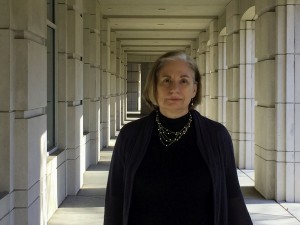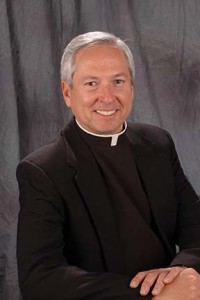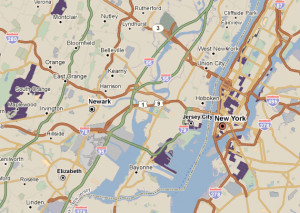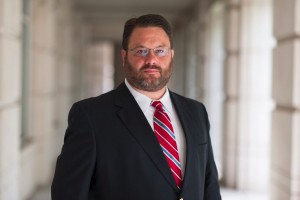Please note that during midterms (ending Monday March 28th) and the start of our 24/7 period through final exams (8a Sunday April 17th until 11p Tuesday May 10th) guest access to the library’s computers will be restricted to SHU alumni. There will be no guest access to computers for non-alumni community users at these times.
Dr. Marta Deyrup selected for Fulbright Specialist grant at the American University of Central Asia
Dr. Marta Deyrup, Head of Technical Services, will spend three weeks in April as a Fulbright Specialist at the American University of Central Asia in Kyrgyzstan, where she will assess user services and collection development policies at the library. The AUCA , which is located in the capital, Bishkek, was founded in 1993 to develop future leaders for the democratic transformation of Central Asia. This is Deyrup’s third award as a Fulbrighter—earlier she received grants to consult and teach Library Science in Rabat, Morocco and Zadar, Croatia.
In the Libraries: Research Relationships Interviews Rev. Thomas Guarino – February 2016
In the Libraries: Research Relationships
Seton Hall is home to world-class researchers whose work denotes a broad array of scholarship. In this space, we share their ideas on research and making the most of the academic experience.
Rev. Thomas Guarino is Professor of Systematic Theology at Seton Hall’s Immaculate Conception Seminary School of Theology. His most recent book, Evangelicals and Catholics Together at Twenty: Vital Statements on Contested Topics explores the key accomplishments of the groundbreaking, ongoing dialogue between Evangelical and Catholic Christians (read an excerpt here).
We caught up with Rev. Guarino to talk about his research.
You research, publish and teach, and, you have been recognized for your work. How do you find time to balance all these activities?
Of course all Faculty members face this same issue—trying to teach well, do your research, write. It’s work, but I think it’s important for the students to understand that nothing in life comes easily. Any type of noteworthy achievement is the result of intensive effort.
I like to mention this story about research:
Jaroslav Pelikan was a famous historian at Yale University, and he used to tell students “If you have a choice between a great teacher who doesn’t do research, and an average teacher who does research, take the latter.” And his point was that even though the person is an average teacher, he or she is involved with the field, is engaged. So it’s always important to stay with somebody who’s doing at least some research.
Do you have clerical responsibilities in addition to your academic work?
Of course I’m a priest, and to celebrate the liturgy is part of who I am as a priest. I also try to be available to people, particularly to those who wish to talk about issues affecting their lives. So, yes, I try to be available as a priest to all members of the Seton Hall community.
But my main job on campus is to teach, write, and research Theology, so I spend most of my time doing that. I see my life as a priest and my work as a theologian as convergent realities, precisely because I’m writing all the time about this question: “What role does God play in life?”
One of the advantages of a Catholic university is that faith and reason are seen as conjunctive realities. The library is a great representative of the tradition of reason, the tradition of seeking knowledge and truth. At the same time, one of the axial and bedrock principles of Catholicism is that faith and reason are not opposed. Sometimes in journalistic narratives they’re presented as opposing points of view, but in the Catholic tradition faith and reason are deeply convergent since both are gifts of God. A Catholic university is a special place where faith and reason come together.
In what ways have Seton Hall University Libraries (books, databases, ebooks, ILL service, librarians) assisted your research process?
I’ve moved on from this book and I’m now researching a book on the Second Vatican Council. The Church just celebrated the council’s 50th anniversary. In many ways Vatican II was the most important ecclesial event of the 20th century—and its ramifications are still being debated. Vatican II gave birth to official Catholic involvement in the ecumenical movement.
The book Evangelicals and Catholics Together is part of a wider spectrum of Catholics being engaged with Episcopalians, Methodists, Presbyterians, Lutherans and Evangelicals in ecumenical dialogue. Inter-religious dialogue is important, too, with Judaism, Islam and other religions. Vatican II gave birth and impetus to all of these initiatives, and the library is a great repository of the documents and all of the commentaries that have been published since then. I deeply appreciate those vast library resources.
The databases are excellent; I usually start my own research with Academic Search Premier—I find that to be a comprehensive listing of academic journals. Because of my field I usually then move on to the American Theological Library Association’s (ATLA) Catholic Periodical and Literature Index. The Philosopher’s Index has also been very important to me. We also have a wonderful database Patrologia Latina, which has all of the writings of the early Christian authors in the original Latin, so you have those original texts accessible. And I just discovered—I think this is a recent acquisition—we have the Digital Library of Classic Protestant Texts which has all the works of Luther and Calvin in the original and, when available, in English translation. It’s a terrific resource for the kind of ecumenical work that Evangelicals and Catholics Together represents.
However I do want to say to students: we’re all seduced by computers and digital research—but there’s a great joy in shelf browsing. How many times have we experienced this: you’re looking for a particular book, but then you see 10 books alongside of it of which you were unaware—books which treat a topic in unique ways you didn’t at first realize.
Even though I spend most of my time in Walsh Library I do want to mention the importance of the Turro Seminary Library. It was built as a graduate theology library. Consequently, it has more resources in Latin, more books from the earlier tradition of the Church, more collections that perhaps would have been inaccessible to undergraduates but would be familiar to graduate students. Stella Wilkins is the librarian there and she and her staff have been very helpful.
Many of our students are undergraduates who are just beginning to develop their research and writing skills. Is there any advice research you offer your own students that we can share with them?
I think students can easily be intimidated by all that’s available today; it’s almost too much for them to digest. One of the things we try to do in the School of Theology is to conduct Research Seminars during which we introduce students to the library resources. We have not only librarians, but librarians and faculty together involved in these seminars. We go through the resources of Turro Seminary Library, and then the resources at Walsh Library, and try to introduce them to the basics of what library research is all about.
I often tell students one of the most profitable things they can do is take two hours and just go through the digital resources available on the Library website. They will find extraordinary resources they didn’t know existed.
Listen to Father Guarino Talking About His New Book “Evangelicals And Catholics Together At Twenty”
The Art and Science of Space
Monday, February 15, 2016
By Michael Ricciardelli
Over the last few years, Seton Hall’s Walsh Library has undergone a number of subtle but comprehensive changes.
Utilizing the latest in design, psychology and cognitive science, the library, which first opened its doors in 1994, has been revitalized and reconfigured to keep pace with 21st century learning and to provide space that better facilitates study, writing, research, collaboration— and even conversation.
As a result, library usage is up considerably and the space teems with students, faculty and guests on any given afternoon.
The library’s transformation has been spearheaded by the Dean of Libraries, John Buschman, who came to Seton Hall from Georgetown University in 2012, where he served as Associate University Librarian for Scholarly Resources and Services. Dean Buschman has been praised in the Journal of Librarianship and Information Science for having “examined and analyzed the role of libraries and educational institutions vis-à-vis democracy in a series of complex, insightful books and essays over the last decade.” His most recent book was likewise acclaimed as “essential reading to understand the status of library services in the 21st century.”
“With well over 600,000 visits per year, the library is a hub in the academic life of the University, a partner in the educational process and an indispensable part of Seton Hall’s social fabric. And we have worked hard to make it so,” said Dean Buschman. “In addition to numerous technology updates and the dramatic expansion of our resources, we’re doing all we can to make our library more accessible, more accommodating, ergonomic and all-around ‘user-friendly.’”
Dean Buschman’s assistant, Jody Drafta, has helped to implement his vision and is, herself, co-author of a chapter entitled “Principles of Good Design” in the book Creating the High-Functioning Library Space: Expert Advice from Librarians, Architects, and Designers. Forthcoming in 2016, Seton Hall professor, librarian and Fulbright Specialist Marta M. Deyrup is the book’s editor.
In it, Drafta writes,
Good library design results in spaces that are both functional and feed the human spirit, often without their inhabitants fully understanding what draws them in to these spaces and causes them to linger. Important components of good design include the scale of the space and the furniture that supports it, the curated use of color and texture, spatial and visual variety, and the qualities of natural and electric light. Carefully choreographing these aspects results in inviting spaces that resonate with people and support their well-being.
Putting Theory into Practice
In addition to major plant maintenance that included a new roof, new cooling tower and a power wash of the library’s iconic façade, interior renovations have focused on color, furnishings, technology and the use of signage and embedded visual cues to render the space more inviting and intuitively navigable.
And as any student of interior design will tell you, good design starts with the entrance, or what many cognitive scientists and marketing professionals involved in the configuration of public and retail spaces refer to as “the decompression zone,” the space where one first enters a building and the mind transitions to its new surroundings and receives its first impressions, setting the tone.
Welcome
Offering a warm and spirited introduction, in Walsh Library that space is signaled by a harvest gold backdrop and a block lettered sign above the reception desk that reads “WELCOME TO SHU LIBRARIES.”
The Libraries’ “Welcome Message” was hand painted by Jon Bocksel, who learned the lost art of sign painting as an apprentice to experts in hand-lettering— a largely forgotten craft that hearkens back to the era before digitally-produced signs. Before painting the Seton Hall signage Bocksel spent a morning on campus with the University Archivist going through yearbooks, publications, Seton Hall insignia as well as sports uniforms which, Bocksel notes, are often rich carriers of institutional self-expression in the form of typeface choices. Drawing from this graphic heritage, he returned to his studio and then, after further study, painted the “Walsh Welcome” in a font and style that reflected anew Seton Hall’s traditions.
Color
A great deal of study and scholarly writing has been devoted to the psychological and physiological impact of color, especially as it concerns concentration and memory. In Walsh Library, to reframe and enliven the space as well as form a cognitive aid, the entire building interior was painted a lighter color, with bolder colors (blue and yellow) keyed to the front of the building on each floor to help both zone the space, and assist in cognitive mapping and way-finding. Adding to these efforts, colored tracking was added into the carpet to function as lines of demarcation and as a visual pointer, delineating the stacks within the space.
Furniture & Technology
In her essay on library design, Drafta notes that in addition to supporting comfortable and focused study, furniture can play a key role in configuring space:
Furniture layout signals the intent of a space. As with zoning, furniture plays a role in cueing behavior by either encouraging or dissuading various activities within a given space. For example, areas designated for quiet, individual work should not include conversational layouts of lounge furniture, but rather individual seats that are not easy to move into collaborative layouts. Conversely, an area meant for creative collaboration should be furnished in such a way that prompts and supports this behavior, with flexible furniture and brainstorming accessories.
One can readily see the theory at work in Walsh Library. The Information Commons on the second floor bustles with its sectional seating groups, where newly purchased Herman Miller soft seating allows for both solo and collaborative work. Amidst traditional tables and chairs, the Izzy café tables and stools (also new) provide a change in the topography of the room and allow for more relaxed conversation space. New computer chairs accompany 15 new iMacs and 55 refreshed and reconfigured PCs, affording students the best of contemporary computing technology and ready access to the vastly expanded data and scholarship resources.
New chairs and group work tables with whiteboard scalloped tops have been added in the Curriculum Resource Center (which doubles as the newly created graduate student lounge). The award winning tables (which look a little like pieces of Swiss cheese with a series of half-moons cut out of them) are designed to facilitate collaboration by bringing students significantly closer together than they would be at a traditional conference table.
The Seton Hall Chair
Juxtaposed against and atop this lively interplay of resource and collaboration, on the upper floors one finds the muted cherry elegance of the study carrels and their famed three position rocker, “The Seton Hall Chair.” Newly reupholstered after 20 plus years of use, the chairs were designed by renowned master craftsman Thos. Moser with the help of Monsignor Dennis Mahon and then President and Chancellor Rev. Thomas R. Peterson. The Seton Hall Chair was constructed to offer ergonomic support to students when they lean forward to type, back when they read, or even in between. In his book, Artistry in Wood, Moser, who went on to design and build chairs for both Pope Benedict and Pope Francis as well as a number of other academic institutions, described building “The Seton Hall Chair” as having been “hired to create the ultimate ergonomic library chair.”
Additional Work and Future Renovations
Additional work includes the Library’s silent study rooms, which have all been renovated with new and reupholstered furnishings as well as updated technology; the addition of Herman Miller FloArms at the reference desk, which are adjustable, flexible computer monitor arms that let the student and reference librarian look at the same information on separate, individual screens during consultations; the installation of height-adjustable tables for disabled students; and a Graduate Student Lounge, a newly created communal work space for graduate students— which runs 4:30-7:30 p.m. Monday through Thursday during Fall and Spring semesters.
Future renovations will continue to focus on “spatial lucidity” and ergonomics to facilitate study and collaboration as well as technological advances and catalogue expansion to further enable research and scholarship.
In addition, the reorganization and integration of the Seton Hall University Museum of Anthropology and Archaeology (SHUMAA) into the Seton Hall Libraries will give students and scholars ready access to the collection, which includes more than 26,000 pieces of Native American, Asian and African art and artifacts — as well as some Greek, Roman and Byzantine pieces.
This new resource, combined with the Libraries’ Walsh Gallery, which hosts five art exhibitions annually as well as scholarly events such as the renowned Poetry-in-the-Round series— featuring readings by award winning authors— symposia, film screenings, artist talks and meeting space for events, will further cement the University Libraries’ status as a cultural and academic hub at Seton Hall.
Dean Buschman concluded, “The Libraries are at the heart of Seton Hall’s intellectual ambitions. They are the first source for scholarship, a place where students’ needs are the top priority and where faculty draw on essential resources for their teaching and research. The libraries foster intellectual integrity through user-focused services and collections, and consequently, students graduate with the realization that the library is indispensable.”
New Research Tool: PolicyMap
The University Libraries have recently acquired the online data mapping tool PolicyMap. PolicyMap is a Geographic Information System (GIS) pre-populated with more than 37,000 continuously updated data sets including information on demographics, home sales and mortgages, health statistics, socioeconomics, jobs and employment, and more.
From the company:
PolicyMap is an online data and mapping tool that enables government, commercial, non-profit and academic institutions to access data about communities and markets across the US. Use it for research, market studies, business planning, site selection, grant applications and impact analysis.
Universities use PolicyMap in a variety of schools and curriculums, such as social sciences, urban planning, public policy and business administration. It allows them to focus on analyzing data – not collecting it or learning how to use expensive mapping software.
What can students and faculty do with PolicyMap?
- Generate maps and tables to incorporate in reports and presentations
- Search by address, city, state, zip code, county or census tract
- Create topical reports by predefined region, radius, or custom-drawn region
- Compare data across geographies or view trends over time
- Find communities meeting up to 3 criteria on a map
- Download select datasets as csv files
- Rank geographies across an indicator
- Create custom regions for unique analysis
- Upload your own point level data
- Incorporate work into papers and presentations
What kinds of indicators will they be able to access?
- Demographic estimates and projections
- Income and poverty measures
- Employment by industry
- Homeownership rates and affordability
- Home Sales
- School performance
- Quick community profiles
What types of analyses can they conduct?
- Compare obesity rates among states
- Track mortgage lending patterns in a city
- Understand the racial and ethnic composition of a community
- Identify neighborhoods with certain income and household characteristics
- Draw a unique geography on a map and generate a comprehensive report of the areas’ demographic and economic characteristics
- Upload other data and leverage it against the trusted data available through PolicyMap
How could they use their analysis in class?
- Make a case for a particular public policy intervention
- Argue for a particular site for a business
- Describe a market for a business plan or marketing strategy
Pop Up Museum – Thursday, February 11th
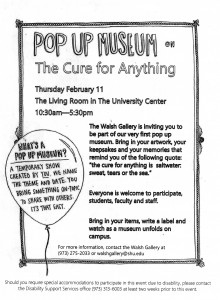
John Irwin appointed to PALCI ’s EZ Borrow Advisory Council
John Irwin, the Head of Access Services and an Assistant Professor at Seton Hall University Libraries, has been selected to fill one of the vacancies on the Pennsylvania Academic Library Consortium Inc. (PALCI)’s EZ Borrow Advisory Council.
PALCI membership consists of nearly 70 academic and research libraries (including Seton Hall University Libraries), private and public, in Pennsylvania, New Jersey, West Virginia, and New York. Member institutions range from small liberal arts colleges to publicly funded universities to ARL institutions to the State Library of Pennsylvania. Libraries in PALCI have holdings in excess of 36 million volumes and a combined FTE of more than 500,000 students.
During his term, which will run from November 2016 through June 2017, Professor Irwin will be advising on services and system enhancements to improve access to member collections. Member libraries enjoy an active program of resource-sharing, cooperative purchasing, collaborative collection development, and professional engagement.
Congratulations John!
Hand-painted ‘Welcome to SHU Libraries’ Sign Added to Walsh Library
Over the course of the last three and a half years, the library’s appearance and functionality have steadily been revised to provide among other things, a clearer sense of place. One recent change in this vein was the addition of a hand-painted sign above the circulation desk. The new sign gives a robust welcome to students and other patrons of the library. It was painted by a young artist and hand sign-painter named Jon Bocksel. Jon learned the arcane trade of hand sign-painting over several years as an apprentice to experts in hand-lettering from the time preceding digitally-produced signs. In planning for a commission, he absorbs a large amount of visual information before embarking on the design process. For the Seton Hall sign, he spent a morning on campus conferring with University Archivist Alan Delozier and took back many images to his studio. Alan had gathered yearbooks, insignia, and the Seton family’s as well as the University’s crest as a corpus of visual context for Jon on Seton Hall. Alan also showed Jon two fascinating and little-known murals of SHU sports teams, located in the University Sports Center and painted in the 1940’s by a recognized fresco painter of Italian cathedrals, and immigrant to New Jersey, Gonippo Raggi (https://en.wikipedia.or/wiki/Gonippo_Raggi).
Jon’s final sign references the history of SHU publications as well as sports uniforms which, according to him, are often rich carriers of institutional self-expression in the form of typeface choices. All in all, his sign sets off the entrance space to the library in an emphatic way that provides directness and warmth. Welcome to SHU Libraries!
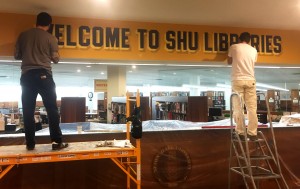
Graduate Student Lounge Returns!
For the Spring 2016 Semester, the Curriculum Resource Center will once again become the Graduate Student Lounge (GSL) space. Starting Monday, January 11th for the first 11 weeks of the semester, the GSL will run Monday – Thursday, 4:30PM-7:30PM. The space features 2 hard-wired Mac computers, a digital projector and monitor, whiteboard and flexible group seating. The room will be staffed by trained graduate students who can provide basic information regarding resources on campus such as the ID process, course registration, parking, career services, PirateNet, IRB documents, and classroom locations.
In addition, ‘guest’ presenters from various areas, such as financial aid and library services, may participate at key points in the semester when those services are most needed. And of course the Library is always staffed with Reference librarians, Circulation staff, technology help, and specialized information consultation services which can be scheduled. This space provides support for the range of needs and issues that graduate students face: quiet space, group study space, research support, IT support, presentation practice/equipment, and an opportunity to connect with other graduate students.
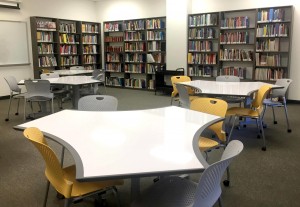
New Database Trial: British Periodicals
A trial of ProQuest’s database British Periodicals available to SHU students and faculty until December 18th. This resource offers research materials across many disciplines including history, literature, political science, journalism and the arts. The trial can be accessed here.
We welcome feedback from trial users. Please send any comments to Sebastian Derry, Assistant Dean of Public Services at sebastian.derry@shu.edu
From ProQuest:
This database provides access to the searchable full text of hundreds of periodicals from the late seventeenth century to the early twentieth, comprising millions of high-resolution facsimile page images. Topics covered include literature, philosophy, history, science, the social sciences, music, art, drama, archaeology and architecture.
Subject coverage
- The Periodical Press
- Victorian periodicals
- Popular culture
- Literary Journalism
- Essays and Belles-Lettres
- Illustrated Periodicals
- Literary Criticism
- Political Satire
- Politics / Political Science
- Fine Arts
- Serial Fiction / Serialized Fiction / Serial novels / Serialized novels
- Slavery and Anti-slavery movements
- Temperance
- Religion and Theology
- Methodism
- English Poetry
- Book reviews
- Science
- Economics
- Bibliography
- Sport
- English literature / English writing / English periodicals
- Scottish literature / Scottish writing / Scottish periodicals
- Irish literature / Irish writing / Irish periodicals
- Women’s literature / Women’s writing
- Theatre / Theater / Drama
- Seventeenth-century literature / Seventeenth-century writing / Seventeenth-century periodicals
- Eighteenth-century literature / Eighteenth-century writing / Eighteenth-century periodicals
- Nineteenth-century literature / Nineteenth-century writing / Nineteenth-century periodicals
- Twentieth-century literature / Twentieth-century writing / Twentieth-century periodicals
- Advertisements

